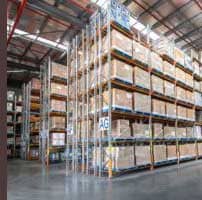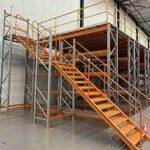Ensuring Racking Safety and Compliance
Pallet racking systems are integral to warehouse operations, distribution centres and businesses that require safe and efficient storage of pallets and bulk goods. These storage systems are constructed from industrial-grade steel. They are prone to impact damage, particularly from the constant loading and unloading activities. Therefore regular inspections and audits are critical to identifying potential risks and ensuring the safety and longevity of your racking system. This blog post gives you an inspection checklist as advised by Australian Standard AS4084:2023 and offers insights into maintaining a compliant and safe storage environment.
Table of contents
- Ensuring Racking Safety and Compliance
- What Is Rack Inspection?
- Racking inspection checklist: What to look for
- Types of Racking Inspections?
- Who is a competent person for racking inspections?
- How to inspect a rack?
- Racking Damage
- Next Steps
- Frequently asked questions about pallet racking inspections checklist
- 1. How often should racking be inspected?
- 2. Does racking need a SWL?
- 3. Who is a competent person in racking inspection?
- 4. After the formal rack inspection is complete, is my racking certified?
- 5. How long does a racking inspection take and what are the costs involved?
- 6. How long do I have to keep racking documentation?
- 7. How do I book a rack inspection?
What Is Rack Inspection?
Audits and inspections are a crucial aspect of ensuring warehouse safety and efficiency. Warehouse racking, also known as industrial storage or shelving systems, provides a valuable storage solution for many businesses. However, these structures are susceptible to damage from wear and tear, forklift collisions, and other potential safety hazards. Regular inspections are necessary to assess the structural integrity of the racking and identify signs of damage that could lead to a collapse or other hazards in the workplace. This is where racking inspectors, introduced as competent persons in the standards, perform racking audits at least annually to ensure the manufacturer’s guidelines and racking regulations are being followed.
When it comes to pallet racking, this racking inspection checklist ensures that all aspects of the racking are thoroughly examined. From dents and structural damage to deflection and rust or corrosion, inspectors look for any signs that could compromise the safety of the system. Column protectors and other safety measures like connectors and safety pins are also checked to prevent potential hazards in the warehouse. Even minor issues like scraped paint or wear and tear can indicate a larger problem that needs to be addressed to maintain a safe working environment for warehouse staff.
Ignoring the importance of rack inspection can have serious consequences. A racking collapse could result in injuries, damaged inventory, and costly repairs. By staying proactive and conducting regular inspections, businesses can prevent accidents and ensure the longevity of their storage systems. Whether it’s a small dent from a forklift collision or a larger issue with structural damage, addressing these issues promptly is essential for maintaining a quality pallet storage solution.
Racking inspection checklist: What to look for
Inspections of racking and unit loads shall be conducted to check that racking is being used as specified and damage is being reported and rectified.
Inspections, reports and repairs relating to racking shall be documented and retained by the end-user until the racking is removed from service.
Pallet racking should be inspected frequently for damage and overloading. Damage incurred, however minor, shall be reported and documented immediately to enable the effect on safety to be assessed immediately. Hazardous situations involving the operation or maintenance of the racking installation shall be reported, actioned, and documented immediately.
The manufacturer, supplier, or a competent person is to provide documents detailing inspection requirements, damage reports, and steps to be taken when damage occurs.
The ongoing safety of the storage equipment is the responsibility of the end user.
The rack inspection checklist, as per AS4084:2023, outlines several key areas to focus on during a racking inspection:
- Equipment Usage and Specific Application:
Determine that the storage equipment is being applied and used as specified.
Racking in external environments shall comprise components which are either hot-dip galvanised or manufactured from pre-galvanised coil. If powder-coated racking is installed externally, the frequency of formal inspections shall be increased in order to monitor the degradation in the protective coating over time. - Working Load Limits:
Determine that working load limits for unit and bay loads are current and being adhered to. The unit load limit per storage level and the total unit load limit per bay for the racking installation shall not be exceeded. The permissible unit load limit and permissible bay load limit shall be displayed on SWL signage. - Unit Load Dimensions:
Ensure unit loads adhere to specified dimensions such that operating clearances are maintained and specified. - Stability:
Determine that unit loads are stable. - Modifications:
Confirm any modifications are documented and compliant, either on the load sign or configuration drawings kept on site. - Signage:
Check that all signage is current, legible and free from damage and obstruction. - Component Consistency
Inspect for consistency with the design in all racking components, including frames, beams, floor fixings, bracing and ancillary devices. - Damage Assessment
Assess for any impact damage or wear to racking uprights, beams, baseplates and frames. - Plumbness and Alignment:
Ensure uprights are vertical and properly aligned. Check for out-of-plumb (non-vertical) racking uprights in both the cross aisle and down aisle directions. - Safety Features
Check for the presence and condition of safety locks and connectors. Check that all beams are fitted with the beam safety locks/pins into the upright. Examine the beam connectors for disengagement, deformation, and signs of welding or cracking. - Corrosion and Wear:
Identify any signs of corrosion and excessive wear of any component including upright frames, beams, beam connectors, safety clips (beam clips), frame, plan and spine bracing and floor fixings. - Base Plates and Floor Fixings:
Inspect the condition and security of base plates and fixings. - Floor Condition:
Examine the floor for damage or unevenness. Check for signs of deformation, out of level and cracks. - Building Attachments:
Verify compliance with regulations regarding attachment to building structures. Racking should not be attached to a building unless it has been approved by a structural engineer. - Fall Protection:
Check that netting and mesh are installed where the product stored at a height in the racking could fall onto pedestrians.
Types of Racking Inspections?
There are 2 types of racking inspections informal inspections and formal inspections.
Informal inspections
Informal inspections are the responsibility of the end user. The end user may nominate a person to conduct these informal inspections.
The frequency of informal inspections should be based on the recommendations of the manufacturer or competent person based on a risk assessment, either daily, weekly or as otherwise recommended.
Informal inspections are predominantly conducted visually from ground level with the aid of simple gauges and measuring tools.
Formal inspections
Formal inspections shall be conducted by a competent person at intervals not exceeding 12 months as determined by the results of a risk assessment and the recommendations by a competent person.
Formal inspections of racking systems under 8 m in height may be conducted visually from ground level.
Formal inspections of racking systems above 8 m in height should be conducted using systems and equipment such as elevating work platforms or other ground-based technologies.
The results of the formal inspection shall be documented and include observations and proposals for any corrective action. This document must be kept for the life of the racking system.
Who is a competent person for racking inspections?
The application of competency across many layers of the new standard is a key feature of the changes designed to ensure qualified individuals are involved every step.
The definitions are as follows:
Competent Person – General
According to 1.3.8 of the Australian Standards for Steel Racking AS4084.2-2023 a competent person is a person who has acquired through training, qualification or experience the knowledge and skills to carry out the task effectively and safely. A competent person may include the manufacturer, supplier or racking designer.
Competent Person for Formal rack Inspections
A competent person (1.3.8) who carries out formal inspections as specified by the manufacturer, supplier or racking designer, should:
- have worked in the industry as a racking designer, engineer or installer or have similar experience
- understand the requirements for the relevant brand and type of storage racking being inspected; and
- possess the skills to oversee racking installation and repair.
Competent Person for repairs
Given the highly engineered nature of pallet racking systems, only a competent person is authorised to undertake repairs.
Competent Person for informal rack Inspections
Daily or weekly inspections must be conducted by the end-user or their nominated person.
How to inspect a rack?
Inspection of a rack requires thorough scrutiny of each part for potential damage and issues associated with all components, including:
- Base plates, shims, and anchors.
- Upright columns and braces.
- Beams, connectors, safety pins.
- Safety bars, wire mesh decking, and other rack accessories.
- Clearances, pallet overhang, protection, load capacity labels.
Racking Damage
Racking damage from impact, usage or the environment as determined from informal and formal inspections shall be assessed. Damage to racking shall be classified in an escalating hierarchical racking damage colour coding system designated by “green”, “amber” and “red” levels of severity (risk). Damage categorised as “green” is deemed acceptable, “amber” is deemed hazardous, and “red” is deemed very serious.
Next Steps
- Learn More: Read our article on whether you should repair or replace damaged pallet racking or improve warehouse safety with rack protection or the 6 key essential facts about pallet racks
- Get a Quote: for Sydney pallet racking annual inspection or racking audit
- Reach Out: For more information or assistance, contact Total Racking Systems.
Frequently asked questions about pallet racking inspections checklist
1. How often should racking be inspected?
How often should racking be inspected across your facility? The Australian standard AS4084:2023 recommends that an informal rack inspection be conducted on a daily or weekly basis. However, a formal rack inspection must be completed at least every 12 months unless risk assessments require it to be taken more frequently, like every 6 months. The formal inspection must be conducted by a competent person, who is someone who has worked in the industry as a racking designer, engineer or installer.
2. Does racking need a SWL?
New signage requirements in AS4084:2023 allow for alternate ways to demonstrate the load-carrying capacities of reaching systems, ensuring safety measures and inspection protocols.
New racking should be supplied with Weight-Load Signs upon completion of the installation and before it is used. The newly installed racking needs to be inspected before it is operational. This inspection should identify any racking where a Load Sign is not displayed.
3. Who is a competent person in racking inspection?
The updated standard AS4084:2023 introduces the concept of a Competent Person who should handle the design, annual formal inspections, repairs, and maintenance of storage racking systems.
4. After the formal rack inspection is complete, is my racking certified?
No, a rack inspection confirms the state of your racking and what is damaged or needs to be monitored. The inspection is the first step to getting your workplace certified. If no damages are found, you will receive your certification notice. Otherwise, you must complete the required repairs to gain certification.
5. How long does a racking inspection take and what are the costs involved?
A proper racking inspection will take a few hours at minimum, but depending on the facility size, it can span multiple days. Racking inspection costs vary from a few hundred dollars to thousands, depending on the scale and whether any raised equipment is required.
6. How long do I have to keep racking documentation?
Documentation, including manuals, racking inspection audits, and repair logs, needs to be kept for the life of the racking system to demonstrate a history of maintenance and compliance.
7. How do I book a rack inspection?
You can book anytime via our contact form or by calling our office. We work with you to ensure your inspection and report are conducted at a time that suits your company’s needs and timetable.





